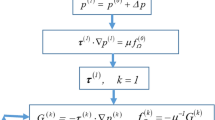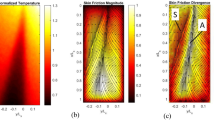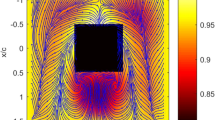Abstract
High-resolution skin friction fields in separated flows on a low-aspect-ratio rectangular wing are obtained by using quantitative global skin friction diagnostics based on surface luminescent oil visualizations. The topological features like the isolated singular points and the boundary switch points in regions enclosed by penetrable boundaries are identified. The conservation law given by the Poincare–Bendixson index formula for the numbers of the isolated singular points and the boundary switch points is used as a general approach to analyze the topological structure of a skin friction field in a singly connected region enclosed by a penetrable boundary in the separated flows.













Similar content being viewed by others
References
Chapman GT, Yates LA (1991) Topology of flow separation on three-dimensional bodies. Appl Mech Rev 44(7):329–346
Chern SS (1967) Studies in global geometry and analysis. The Mathematical Association of America, Wahington, p 44
Chow SN, Hale JK (1982) Methods of bifurcation theory. Springer, Berlin, pp 65–88
Dallmann U (1983) Topological structures of three-dimensional vortex flow separation. AIAA Paper 83-1735, July, Danvers, MA, USA
de Leeuw WC, van Liere R (1999) Collapsing flow topology using area metrics. In: D, Gross M, Hamann B (eds) Proceedings IEEE visualization’99 Ebert, pp 349–354
Délery JM (1992) Physics of vortical flows. J Aircraft 29(5):856–876
Délery JM (2001a) Robert Legendre and Henri Werle: toward the elucidation of three-dimensional separation. Annu Rev Fluid Mech 33:129–154
Délery JM (2001b) Robert Legendre and Henri Werle: toward the elucidation of three-dimensional separation. J Aircraft 29(5):856–876
do Carmo MP (1976) Differential geometry of curves and surfaces. Prentice-Hall, Upper Saddle River Chapter 4
Firby PA, Gardiner CF (2001) Surface topology, 3rd edn. Horwood Publishing, Chichester Chapter 7
Foss JF (2004) Surface selections and topological constraint evaluations for flow field analyses. Exp Fluids 37:883–897
Foss JF (2007) Topological considerations in fluid mechanics measurements. Handbook of Experimental Fluid Mechanics. Springer, Berlin Chapter 13
Hartman P (1964) Ordinary differential equations. Wiley, New York Chapter VII
Hornung H, Perry AE (1984) Some aspects of three-dimensional separation. Part 1: streamsurface bifurcation. Z. Flugwiss. Weltraumforsch. 8(heft 2):77–87
Hsieh T, Wang KC (1996) Three-dimensional separated flow structure over a cylinder with a hemispherical cap. J Fluid Mech 324:83–108
Hunt JCR, Abell CJ, Peterka JA, Woo H (1978) Kinematical studies of the flows around free or surface-mounted obstacles; applying topology to flow visualization. J Fluid Mech 88(Part 1):179–200
Izydorek M, Rybicki S, Szafaniec Z (1996) A note on the Poincare-Bendixson index theorem. Kodai Math J 19:145–156
Kinsey LC (1993) Topology of surface. Springer, Berlin Chapter 11
Legendre R (1956) Separation de l’ecoulement laminaire tridimensionell. La Recherche Aeronautique. No. 54, Nov–Dec, pp 3–8
Lighthill MJ (1963) Attachment and separation in three-dimensional flows. In: Rosenhead L (ed) Laminar boundary layer theory, sect. II 2.6. Oxford University Press, Oxford, pp 72–82
Liu T, Shen L (2008) Fluid flow and optical flow. J Fluid Mech 614(11):253–291
Liu T, Montefort J, Woodiga S, Merati P, Shen L (2008) Global luminescent oil-film skin friction meter. AIAA J 46(2):476–485
Liu T, Wang B, Woodiga S (2010) Physics-based optical flow method in global flow diagnostics, AIAA Paper 2010-4361, The 27th AIAA Aerodynamics Measurement Technology and Ground Testing Conference, Chicago, IL, June 27–July 1
Ma T, Wang S (2001) A generalized Poincare-Hopf index formula and its applications to 2-D incompressible flows. Nonlinear Analysis: Real World Appl 2:467–482
Perry AE, Chong MS (1986) A series-expansion study of the Navier-Stokes equations with application to three-dimensional separation patterns. J Fluid Mech 173:207–223
Perry AE, Chong MS (1987) A description of eddying motions and flow patterns using critical-point concepts. Ann Rev Fluid Mech 19:125–155
Surana A, Grunberg O, Haller G (2006) Exact theory of three-dimensional flow separation. Part 1. Steady separation. J Fluid Mech 564:57–103
Surana A, Jacobs GB, Haller G (2007) Extraction of separation and attachment surfaces from three-dimensional steady shear flows. AIAA J 45(6):1290–1302
Tobak M, Peake DJ (1982) Topology of three-dimensional separation flows. Annu Rev Fluid Mech 14:61–85
Wang KC (1974) Boundary layer over a blunt body at high incidence with an open-type separation. Proc R Soc Lond A 340:33–55
Acknowledgements
We would like to thank Prof. Ming-de Zhou and three reviewers particularly the reviewer #1 for their constructive comments.
Author information
Authors and Affiliations
Corresponding author
Appendix
Appendix
1.1 Simple derivation of the Poincare–Bendixson index formula
Consider a vector field on a surface in a region enclosed by a penetrable boundary across which vectors can move freely inward and outward. The relationship between the isolated singular points enclosed by the boundary and the inflow and outflow across the boundary exists as a topological constraint. In fact, this constraint was discussed by Hartman (1964) and Izydorek et al. (1996) in the framework of the Poincare–Bendixson theory. Furthermore, de Leeuw and van Liere (1999) gave a useful form of the constraint on the numbers of the isolated singular points and the positive and negative switch points on the boundary. Here, a more applicable form of the constraint for the flow topology analysis is given as a conservation law between the numbers of the isolated singular points and the switch points in a singly connected region enclosed a penetrable boundary on a surface. It is noted that the following result cannot be considered as a new theorem since it is a direct consequence of the previous works. The intent of this Appendix is to provide an exposition of the Poincare–Bendixson index formula for fluid dynamicists.
Consider an open set Ω ⊂ R 2 bounded by a closed boundary \( \partial \Upomega \) and define τ is a smooth 2D vector field on Ω. It is assumed that there are a finite number of the isolated singular points \( x_{1} , \ldots ,x_{n} \in \Upomega \). The index of τ at x k is denoted by I k = w(C k ) that is defined as the winding number on a small circle C k around x k (Kinsey 1991). We denote B + as the segment of the boundary where τ moves inward across \( \partial \Upomega \) and B − as the segment where τ moves outward across \( \partial \Upomega \). If there exists a point \( Z \in \partial \Upomega \) at which \( B^{ + } \) and B − are divided, this point is called a switch point. There are two types of switch points. If τ in a sufficiently small neighborhood of \( Z \in \partial \Upomega \) moves inward first and then outward across \( \partial \Upomega \), this switch point is negative, which is denoted by Z −. Otherwise, a switch point is positive, which is denoted by Z +, if τ moves outward first and then inward across \( \partial \Upomega \) in its neighborhood. The negative and positive switch points on a boundary are illustrated in Fig. 14. In fact, the positive and negative switch points are also called the internal and external tangent points termed by Hartman (1964) and Izydorek et al. (1996).
Since \( \Upomega \subset R^{2} \) is homeomorphic to a unit disk \( D = \left\{ {\,\left. {\,x \in R^{2} } \right|\,\;|x|\; < \;1\,} \right\} \), the closed boundary \( \partial \Upomega \) is topologically equivalent to a unit circle \( C = \partial D \). The Poincare index theorem for a disk indicates \( w(C) = \sum\nolimits_{k} {I_{k} } \), where \( w(C) \) is the winding number of τ on C that is also the index of C (Kinsey 1991). Further, the winding number w(C) is given by \( w(C) = {{1 + (e - h)} \mathord{\left/ {\vphantom {{1 + (e - h)} 2}} \right. \kern-\nulldelimiterspace} 2} \) according to the Poincare–Bendixson theorem, where e is the number of the elliptical sectors and h is the number of the hyperbolic sectors of τ (Chow and Hale 1982, Firby and Gardiner 2001). As illustrated in Fig. 15, an elliptical sector and a hyperbolic sector correspond to a positive switch point and a negative switch point, respectively. In other words, e is equal to the number of the positive switch points and h the number of the negative switch points. Therefore, the relation between the indices of the singular points in Ω and the number of the switch points on \( \partial \Upomega \) is
Since Eq. (2) is a direct consequence of the Poincare index theorem for a disk and the Poincare–Bendixson theorem, it is simply referred to as the Poincare–Bendixson index formula.
Rights and permissions
About this article
Cite this article
Liu, T., Woodiga, S. & Ma, T. Skin friction topology in a region enclosed by penetrable boundary. Exp Fluids 51, 1549–1562 (2011). https://doi.org/10.1007/s00348-011-1171-6
Received:
Revised:
Accepted:
Published:
Issue Date:
DOI: https://doi.org/10.1007/s00348-011-1171-6






